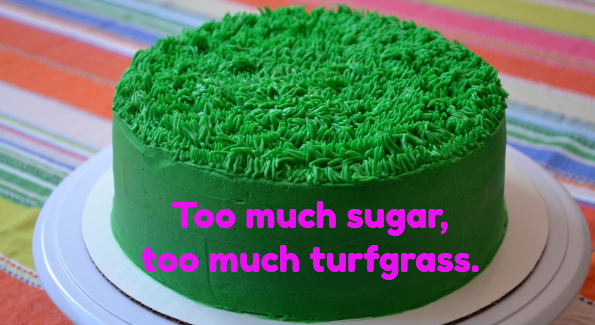Landscape Design: Avoid the Too Much Sugar, Too Much Turfgrass Trap

FREE SERVICE AT THE SHOW: ASK THE DESIGNER!
Landscape designer Arnie Rutkis of Stoneshovel Designs has an important piece of advice for beautifying your landscape: you’re not decorating a cake. Plants, unlike candles, grow. “The cake decorating approach to landscaping,” Rutkis says, involves “putting on lots of pretty plants but not intentionally using plants with a longterm view to size and structure … Too many plants tends to bunch things together. What looks good at installation time ends up growing into a mess.” Rutkis says that it takes proper spacing, good use of negative space, and thinking ten years down the line to develop a great design. And a great design can save you time and money.
If you’re already despairing that your yard is or will be a turfgrass desert or a mess, come to the Native Plant Show, Bradenton, Florida, Oct. 18-19, 2018, and take advantage of the FREE “Ask the Designer” service that Rutkis will be managing with fellow designers. At the “Ask the Designer” booth, homeowners and private property owners can consult with professional landscape designers about plant selection, design strategies and plant care.
Rutkis began his professional life as an artist, and understands beauty. He says that turfgrass does have certain benefits. “It creates pathways and separates space. We just have a tendency as a culture to overuse things — too much sugar, too much turfgrass.” The right balance, aesthetically and ecologically, includes proper use of native plants. To begin achieving that balance in your landscape, come to the show, see the diversity of plants available, learn how to use them and meet professionals that can help you.
Rutkis recommends bringing in a few photos of your landscape, and a simple drawing of the existing plan or a plan you’ve been thinking of. Document the sun orientation, the proximity to water, and if there are any mature trees on the property. Knowing what kind of soil you have, whether sand, loam, or clay, may also be useful. If you have a list of plants you’re interested in using, Wilcox Nursery & Landscape professionals will be on hand to give advice. And if you don’t know much yet about native plants and their ecological importance, the Native Plant Show and “Ask a Designer” service is the perfect place to start learning.
“With every landscape,” Rutkis says, “you have to think about multiple layers.” One layer worth special consideration is ecological function. The perfect space for children to play or adults to host outdoor dinner parties can also make the water cleaner, the Florida sun less brutal, and the birds and butterflies more numerous. “You get that multifunctionality almost exclusively with native plants,” Rutkis says, “because they have a whole host of relationships with all manner of life.” Rutkis gives the example of Asiatic Jasmine, an attractive evergreen ground cover native to Japan and Korea, now popular in Florida landscaping. If Matchweed or Hammock Twinflower (two groundcovers native to Florida) were used instead, they would benefit the surrounding wildlife, because Florida plants and Florida wildlife evolved to use each other. Exotic plants, or nonnative plants largely provide no such benefit. Often, they do the exact opposite, actively harming the natural world.
While a native plant in the right place can get everything it needs to grow and multiply, nonnative plants, by definition, are out of place. St. Augustine grass, for example, says Rutkis “requires a lot of inputs: fungicide, fertilizer, you add all that together and then you have to cut [the grass]. Where do those clippings go? You create a cycle of overuse of heavy chemicals. With such large tracts of grass, if you get a heavy downpour, all of [the nitrogen-heavy clippings, the fungicide, the fertilizer] goes into our waterways.” The Gulf of Mexico experienced a large fishkill this summer. Nonnative landscaping in Florida played a part in that fishkill: heavy nutrients, like grass clippings and fertilizers, leak into the Gulf and create anoxic (lack of oxygen) conditions that kill fish.
Rutkis will also be giving a lecture on creating rain gardens along with landscape architect Robin Pelensky of Surlaterre Landscape Architecture. Rain gardens trap stormwater and neutralize fish-kill causing pollutants carried in stormwater, and are beautiful alternatives to the barren retention ponds of parking lots across the state.
ASK THE DESIGNER sponsored by Wilcox Nursery & Landscape of Largo FL.